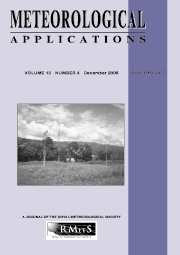Crossref Citations
This article has been cited by the following publications. This list is generated based on data provided by
Crossref.
Gianfreda, F.
Miglietta, M. M.
and
Sans�, P.
2005.
Tornadoes in Southern Apulia (Italy).
Natural Hazards,
Vol. 34,
Issue. 1,
p.
71.
Alcântara, Clênia Rodrigues
and
Souza, Enio Pereira de
2008.
Uma teoria termodinâmica para brisas: teste utilizando simulações numéricas.
Revista Brasileira de Meteorologia,
Vol. 23,
Issue. 1,
p.
1.
Mangia, Cristina
Schipa, Ilenia
Tanzarella, Annalisa
Conte, Dario
Marra, Gian Paolo
Marcello Miglietta, Mario
and
Rizza, Umberto
2010.
A numerical study of the effect of sea breeze circulation on photochemical pollution over a highly industrialized peninsula.
Meteorological Applications,
Vol. 17,
Issue. 1,
p.
19.
De Tomasi, Ferdinando
Miglietta, M. Marcello
and
Perrone, M. Rita
2011.
The Growth of the Planetary Boundary Layer at a Coastal Site: a Case Study.
Boundary-Layer Meteorology,
Vol. 139,
Issue. 3,
p.
521.
Martano, P.
Elefante, C.
and
Grasso, F.
2013.
A Database for Long-Term Atmosphere-Surface Transfer Monitoring in Salento Peninsula (Southern Italy).
Dataset Papers in Geosciences,
Vol. 2013,
Issue. ,
p.
1.
Mangia, Cristina
Gianicolo, Emilio A. L.
Bruni, Antonella
Vigotti, Maria Angela
and
Cervino, Marco
2013.
Spatial variability of air pollutants in the city of Taranto, Italy and its potential impact on exposure assessment.
Environmental Monitoring and Assessment,
Vol. 185,
Issue. 2,
p.
1719.
Rizza, Umberto
Miglietta, Mario Marcello
Anabor, Vagner
Degrazia, Gervasio A.
and
Maldaner, Silvana
2015.
Large-eddy simulation of sea breeze at an idealized peninsular site.
Journal of Marine Systems,
Vol. 148,
Issue. ,
p.
167.
Fedele, F.
Miglietta, M.M.
Perrone, M.R.
Burlizzi, P.
Bellotti, R.
Conte, D.
and
Guarnieri Calò Carducci, A.
2015.
Numerical simulations with the WRF model of water vapour vertical profiles: A comparison with LIDAR and radiosounding measurements.
Atmospheric Research,
Vol. 166,
Issue. ,
p.
110.
Comin, Alcimoni Nelci
Miglietta, Mario Marcello
Rizza, Umberto
Acevedo, Otavio Costa
and
Degrazia, Gervasio Annes
2015.
Investigation of sea-breeze convergence in Salento Peninsula (southeastern Italy).
Atmospheric Research,
Vol. 160,
Issue. ,
p.
68.
Buononato, Elena Viola
De Luca, Daniela
Galeandro, Innocenzo Cataldo
Congedo, Maria Luisa
Cavone, Domenica
Intranuovo, Graziana
Guastadisegno, Chiara Monica
Corrado, Vincenzo
and
Ferri, Giovanni Maria
2016.
Assessment of environmental and occupational exposure to heavy metals in Taranto and other provinces of Southern Italy by means of scalp hair analysis.
Environmental Monitoring and Assessment,
Vol. 188,
Issue. 6,
Torcasio, Rosa Claudia
Federico, Stefano
Calidonna, Claudia Roberta
Avolio, Elenio
Drofa, Oxana
Landi, Tony Christian
Malguzzi, Piero
Buzzi, Andrea
and
Bonasoni, Paolo
2016.
Three-model ensemble wind prediction in southern Italy.
Annales Geophysicae,
Vol. 34,
Issue. 3,
p.
347.
Taylor, J. W.
Choularton, T. W.
Blyth, A. M.
Liu, Z.
Bower, K. N.
Crosier, J.
Gallagher, M. W.
Williams, P. I.
Dorsey, J. R.
Flynn, M. J.
Bennett, L. J.
Huang, Y.
French, J.
Korolev, A.
and
Brown, P. R. A.
2016.
Observations of cloud microphysics and ice formation during COPE.
Atmospheric Chemistry and Physics,
Vol. 16,
Issue. 2,
p.
799.
Kalimeris, Anastasios
Ranieri, Ezio
Founda, Dimitra
and
Norrant, Caroline
2017.
Variability modes of precipitation along a Central Mediterranean area and their relations with ENSO, NAO, and other climatic patterns.
Atmospheric Research,
Vol. 198,
Issue. ,
p.
56.
van der Wiel, Karin
Gille, Sarah T.
Llewellyn Smith, Stefan G.
Linden, P. F.
and
Cenedese, Claudia
2017.
Characteristics of colliding sea breeze gravity current fronts: a laboratory study.
Quarterly Journal of the Royal Meteorological Society,
Vol. 143,
Issue. 704,
p.
1434.
Cristofanelli, Paolo
Busetto, Maurizio
Calzolari, Francescopiero
Ammoscato, Ivano
Gullì, Daniel
Dinoi, Adelaide
Calidonna, Claudia Roberta
Contini, Daniele
Sferlazzo, Damiano
Di Iorio, Tatiana
Piacentino, Salvatore
Marinoni, Angela
Maione, Michela
Bonasoni, Paolo
Helmig, Detlev
and
Flocke, Frank
2017.
Investigation of reactive gases and methane variability in the coastal boundary layer of the central Mediterranean basin.
Elementa: Science of the Anthropocene,
Vol. 5,
Issue. ,
Petenko, Igor
Casasanta, Giampietro
Bucci, Simone
Kallistratova, Margarita
Sozzi, Roberto
and
Argentini, Stefania
2019.
Turbulence, Low-Level Jets, and Waves in the Tyrrhenian Coastal Zone as Shown by Sodar.
Atmosphere,
Vol. 11,
Issue. 1,
p.
28.
Trini Castelli, Silvia
Bisignano, Andrea
Donateo, Antonio
Landi, Tony C.
Martano, Paolo
and
Malguzzi, Piero
2020.
Evaluation of the turbulence parametrization in the MOLOCH meteorological model.
Quarterly Journal of the Royal Meteorological Society,
Vol. 146,
Issue. 726,
p.
124.
Strano, Francesca
Micaroni, Valerio
Costa, Gabriele
Bertocci, Iacopo
and
Bertolino, Marco
2020.
Shallow-water sponge grounds along the Apulian coast (central Mediterranean Sea).
Marine Biodiversity,
Vol. 50,
Issue. 1,
Dinoi, A.
Weinhold, K.
Wiedensohler, A.
and
Contini, D.
2021.
Study of new particle formation events in southern Italy.
Atmospheric Environment,
Vol. 244,
Issue. ,
p.
117920.
Ricchi, Antonio
Bonaldo, Davide
Cioni, Guido
Carniel, Sandro
and
Miglietta, Mario Marcello
2021.
Simulation of a flash-flood event over the Adriatic Sea with a high-resolution atmosphere–ocean–wave coupled system.
Scientific Reports,
Vol. 11,
Issue. 1,




